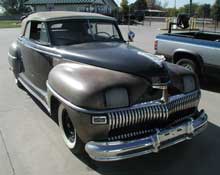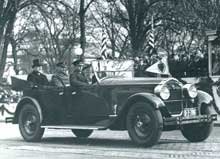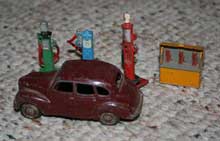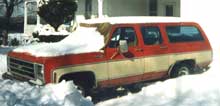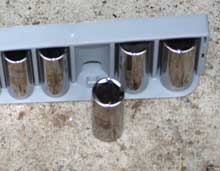On the Avenue
...Fifth Avenue, the photographers will snap us." Irving Berlin, who wrote those words to his song "Easter Parade" in 1948, probably knew about DeSotos, but he could hardly have foreseen Wayne Graefen, the CarPort's Texas Ranger. Wayne gads about in Texas and environs looking for interesting autos. Sometimes he buys them, like the Hupp Eight we featured last summer. Before Wayne could decide what to do with his solid but worn Hupmobile, he happened upon a Hupp aficionado who wanted it badly. Never one to disappoint a salivating enthusiast with cash in pockets, Wayne sold it.
And so last fall he was surfing through the Hot Rod Hot Line, an online marketplace aimed at the rodding fraternity. What should he find but a 1942 DeSoto Fifth Avenue convertible, for sale in Kansas. You'll remember the '42 DeSotos from the CarPort's first season. They're the ones with hidden, "Airfoil" headlights and a host of options which, when bundled together, made up the "Fifth Avenue ensemble." There were just 568 DeSoto convertibles built in the war-shortened 1942 model year. How many could have been Fifth Avenues, do you think? Wayne didn't think too long. He went to investigate and soon he owned the car.
It's solid but a bit forlorn. It was last worked on some 20 years ago, when someone installed an inappropriate vinyl interior. Outside, it's quite presentable, aside from the odd paint on the fenders and a crooked rear bumper, now fixed with a proper mounting bracket. Brightwork is good, the dashboard sparkles and it has the coveted cigarette dispensing steering wheel (some parts are off the car), funky fender skirts, translucent hood ornament and obligatory Fifth Avenue emblems. The engine is neat, if not detailed.
Like Dorothy, the Fifth Avenue awoke to find it wasn't in Kansas any more. In Texas, however, Wayne wondered what he should do. A megabuck restoration would probably not return its cost, and the car is fairly presentable as is. Moreover, he's not sure it's a "real" Fifth Avenue. Each of the options, after all, could be ordered on its own or combined with one or more of the others. Those emblems, moreover, might have been transplanted from another car, perhaps one of more mundane body style. The car itself has taken the Fifth, so he's requested its DNA from Chrysler Historical. While he waits for the verdict, he's installed a nice set of Studebaker wheel covers. They look good, he says, on "any car, any time." From my experience I tend to agree.

